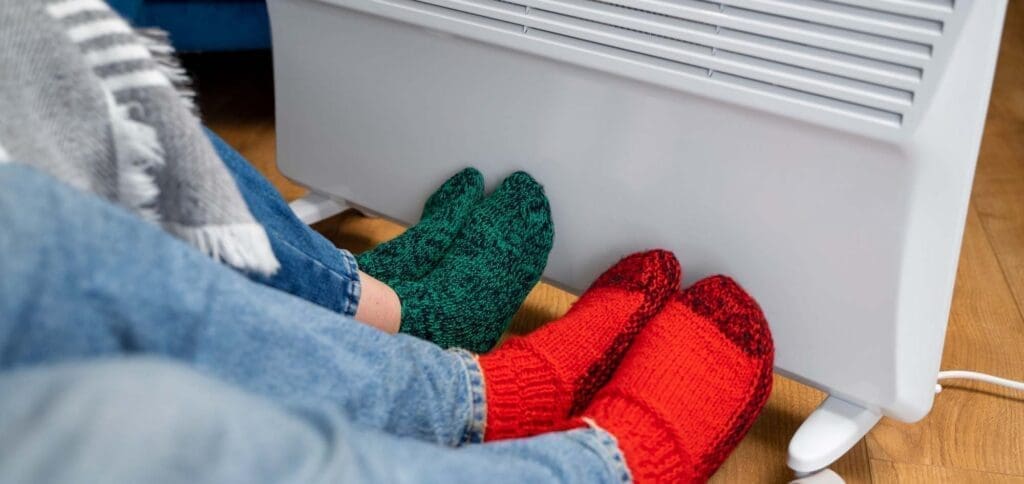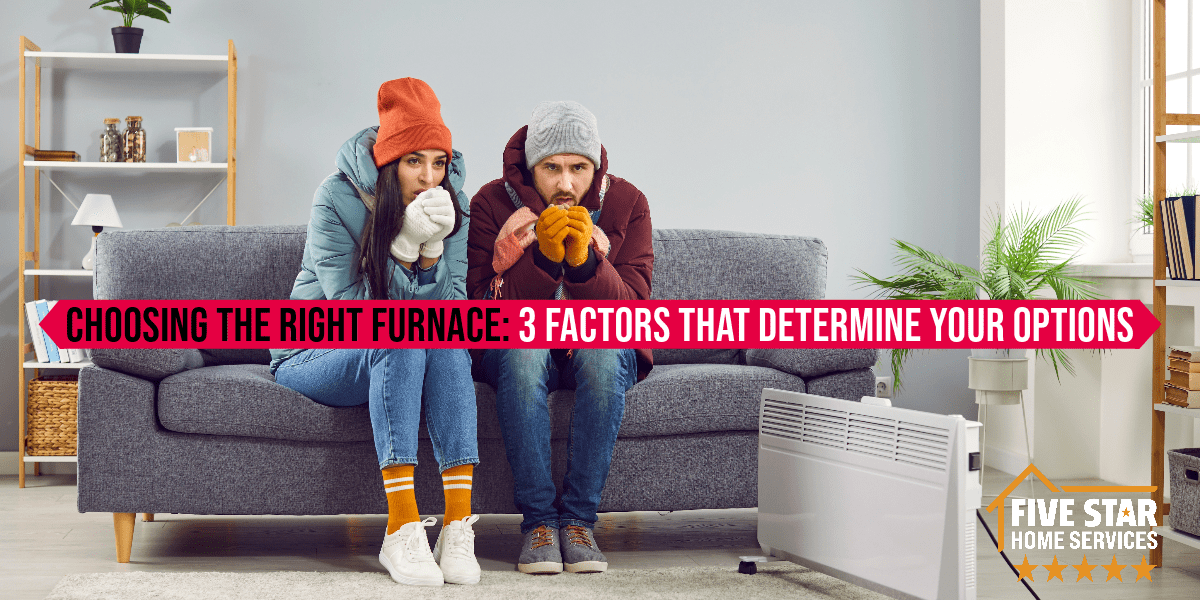Determining which furnace is right for you isn’t easy. Nevertheless, there are multiple factors you can look at to help you make the right decision. In the following article, we will explain how your home, your preferences, and your budget affect your options.
Choosing the Right Furnace: 3 Factors that Determine Your Options
Determining what type of home heating system is right for you can be tricky. Each option brings new technical jargon and figures, and after a while, even the model names run together.
No worries though! We are here to help you get a better grasp of what this technical terminology means for you and your home. As your local home comfort experts, we can honestly say there isn’t a single, one-size-fits-all home heating solution. Nevertheless, we can help you find the best heating solution to meet all your needs.
Although you may have a budget for replacing your furnace — price isn’t the only factor in choosing a system that best suits you and your home. There are multiple options available for every type of budget.
In the following article, we will discuss the types of problems you can solve when replacing your home heating system. We will also look at a few models that may meet your needs and preferences.

Top Three Deciding Factors
If you own a home, you know your HVAC system is a major investment. Fortunately, there are multiple options available for each budget. While you may make your final decision based on your budget, cost isn’t the only factor. Your home and your heating and air conditioning preferences also help determine which systems are right for you.
Your Home
Step one is determining what size your system must be to heat your home adequately. Every type of HVAC system requires in-depth measurements to match your home. It’s not enough to only base the size of a furnace on your home’s square footage.
For example, at Five Star Home Services, we use a Manual J Load Calculation to size the systems we install. Both the U.S. Department of Energy (DOE) and the Air Conditioning Contractors of America (ACCA) state that contractors should use a load calculation – like Manual J – to size residential systems.
A Manual J Load Calculation requires a variety of parameters, including:
- The height of your ceilings
- The directions these windows face
- Your home’s total square footage
- How recently your attic was insulated
- How much insulation your siding provides
- Whether your home has a basement or a slab
- The number, size, type, and condition of your windows
These are several of the parameters we at Five Star Home Services consider when sizing your home. Any HVAC contractor that fails to do so could cost you. You could end up paying more initially and in the long term. In short, bigger isn’t always better. Anything too big overheats the home and kicks on and off much more than it should. On the flip side, anything too small will run longer and work harder than it should. You might also notice hot and/or cold spots in the home.
In both cases, improper sizing can drastically increase your energy bills; it can also cause unnecessary wear and tear on your HVAC system. This drastically shortens its lifespan by as much as 5 to 10 years.
Home Comfort Concerns
Preferences play another big role. When determining the best furnace for you, we at Five Star Home Services look at your home’s comfort concerns. These include your heating and cooling preferences. Comfort concerns include any issues you have with your current system, even if it’s running well.

Furnace replacement is an excellent opportunity to address any issues you have with your current system. Some comfort concerns and other issues that your new furnace could repair include the following:
- noise
- hot and cold spots
- temperature spikes
- expensive utility bills
Nevertheless, determining your comfort concern isn’t an industry standard. In fact, a lot of HVAC contractors skip this step, but your comfort concerns play a major role in determining which furnace is right for you. After all, if you’re going to spend thousands of dollars, it should be on a system that keeps you comfortable.
When we understand your comfort concerns, we can better recommend products that meet your needs.
Your Budget
Furnace replacement costs range anywhere between $3,000 and $11,000. This includes equipment costs, labor, and permit fees. However, it often does not account for any ductwork or ventilation modifications.
After determining the size of your equipment and your comfort concerns, we can then discuss your specific budget.
Because there are multiple options for each budget, the size of the furnace and the comfort concerns it addresses greatly affect its price. Performing a load calculation and identifying your comfort concerns helps to determine the best option. Additionally, you need to figure out which option holds the most value for you. HVAC systems that have the potential to address more comfort concerns will have higher initial costs. Based on your budget, you will probably need to prioritize some of your comfort concerns.
In any case, most modern furnaces have a life expectancy of 15 years or longer. Considering this, it is important to get a system you can live with if you plan to stay in your home long-term.
By prioritizing your comfort concerns, you can find a furnace that matches your home and meets your needs and your budget.
Choosing the Right Furnace for You
Now that we have an idea of the factors that help determine your options, we can discuss some of the types of furnaces and the needs they meet.
In the following, we explore 6 statements that describe different homeowners’ needs and preferences. For each statement, we discuss the types of features that address these needs. Then, we will also recommend specific furnace models with each of these features.
Although we at Five Star Home Services are certified to service or install any brand, we recommend Carrier, Comfortmaker, Amana, and Aprilaire equipment a lot of the time to our customers.
1. You just want a basic model that’s better than your current furnace.
If you’re merely looking for a quality entry-level furnace, the Trane S8X1 or Carrier 58SC could serve you well. However, if you’re looking for a high-efficiency furnace, then the Trane S9X1 may interest you.
Depending on your current home heating system, most newer systems will likely be better in both quality and efficiency. However, if you don’t have any comfort concerns, you might be able to choose based on budget alone.
2. You want a more efficient furnace.
If you want a high-efficiency furnace, check out systems like the Trane S9X2 or the Trane S9V2.
If you have an older furnace — any new system will likely be more efficient than your current system.
Every modern furnace receives an Annual Fuel Utilization Efficiency, or AFUE, rating. This rating describes how much of the fuel a furnace uses and how much actually goes towards heating the home.
For example, an 80 AFUE furnace uses 80 percent of the fuel it burns to heat the home. The other 20 percent, however, is vented as waste gas. Having said that, standard efficiency systems are generally around 80% efficient. However, systems with an efficiency of 90% or higher are highly efficient. The most efficient can reach 98 percent.
Of the models above, the S9X2 and S9V2 can get up to 96 percent efficiency.
Most HVAC manufacturers and utility companies offer rebates and tax credits for systems with at least 96% efficiency. However, these offers may vary depending on where you live, the time of year, and the brand.
Another thing to remember: We may need to modify your ventilation to accommodate a high-efficiency home heating system. This increases the initial cost of your furnace installation.
3. You want a quiet, affordable furnace.
If you own a mid-sized budget and you want a quieter system, you might appreciate a two-stage system like the Trane S8X2 or the Trane S9X2. Variable-speed systems like the Trane S9V2 or the Trane XV80 are even more quiet.
There are several ways we can address the noise levels of an HVAC system. For homeowners who want something more affordable — we normally look at a system’s staging. A system’s staging controls its output. Systems can be single-stage, two-stage, or variable-speed/modulating.
If noise is an issue, we need to look at a system with two or more stages.
Two-stage systems have two settings: 100% and a lower stage that’s typically around 60 to 70 percent of the system’s capacity. Because of this lower setting, two-stage systems are quieter than single-stage systems.
Variable-speed furnaces modulate between 5 and 100 settings, which can range between 40 percent and 100 percent capacity. They are usually the quietest, but typically have the highest initial costs.
4. You plan to stay in your home long-term.
For those planning to be in their home for years to come — you may want to get a variable-speed system like the Trane S9V2 or Trane XV80. Additionally, if you’re interested in intuitive systems, a modulating, communicating system like the Trane XC95M or the Trane XC80 might be a great good investment. We’ll discuss modulating, communicating systems more in-depth later on.
However, if you plan to be in your home long-term, a high-efficiency furnace will benefit you tremendously. Efficiency’s the long game. A variable-speed system could get you the most bang for your buck. Variable-speed systems also have the potential to solve more problems than fixed-speed systems. Variable-speed systems have a longer running time, which can take care of hot and cold spots and dryness. HVAC systems with variable-speed features can fit a range of budgets. While these systems usually have higher initial costs — you can save more money on energy costs in the long run. This makes them a great option for homeowners planning to stay in their home long-term.
5. You want a top-of-the-line furnace.
The Trane XC95M is top-of-the-line in the HVAC industry.
The XC95M is a modulating, communicating system. This means that it has the most advanced technology on the market, which allows it to customize your heating and cooling to the extreme.
The XC95M is also one of the quietest furnaces on the market. Not only is it variable speed, but it also has sound insulation. This further cuts down on the noise the XC95M makes when it kicks on.
Modulating, and communicating furnaces are technically the best you can get. They can solve the most comfort concerns and operate the most efficiently. And if you plan to replace your cooling system with a modulating, communicating system like the Trane XV20i air conditioner or heat pump, then the XC95M can be a great investment.
But the XC95M isn’t always the best furnace for you.
While a fully modulating, communicating system can solve a lot of issues within your home, it won’t do anything for you if you don’t have any issues.
A top-of-the-line furnace like the XC95M also won’t work to its full extent if you don’t plan to replace your current cooling system with a high-end air conditioner or heat pump as well.
If you buy the XC95M, make sure you do so because it’s best for you and your home, not just because of its prestige.
6. You want to add more to your furnace.
Although we aren’t able to add on to your furnace, we can add on to your HVAC system as a whole. This includes entry-level, mid-range, and high-end products. Popular add-ons include indoor air quality (IAQ) products such as humidifiers, dehumidifiers, air purifiers, and filters.
Dehumidifiers, such as our Aprilaire 1850 can be a great investment for homeowners with humidity issues during the summer months. Otherwise, you probably won’t notice a difference if you add a dehumidifier to your HVAC system. Nevertheless, there are a lot of homeowners here in Central Ohio who would benefit tremendously from a humidifier like the Aprilaire 600 or the Aprilaire 700.
In the wintertime, colder weather equates to drier air. Installing a humidifier to your HVAC system puts more humidity into the air in your home. This makes it hold heat better. It also prevents a range of issues, from dry skin to colds. Humidifiers also help preserve wooden floors, doors, and furniture items.
Additionally, air purifiers like the Reme Halo Air Purifier neutralize mold, bacteria, and certain airborne viruses, including COVID-19. They are worthwhile investments if you’re looking to improve your air quality.
Making Sure You Get the Right Furnace
If your situation is unlike those we mentioned above — no worries! There are a variety of options on the market. As your local HVAC partner, we at Five Star Home Services can help you find the right furnace.
Nevertheless, regardless of the type or brand — the most reliable way to get the right furnace is to partner with an HVAC contractor who has your best interests in mind.
An HVAC partner should always do the following”
- Present all of your options without being pushy. We don’t have any sales representatives who only care about making a sale. We care about you! Expensive models may offer more bells and whistles, but if it isn’t the best fit for you and your home, then it isn’t the right option for you.
- Help every homeowner find the best solution for their specific home. HVAC systems are meant to be custom comfort systems. Your system should meet your needs.
- Take the time to do things right. This means taking in-depth measurements of your home, understanding your comfort concerns, and installing your system properly the first time.
Next Steps
If you’ve been researching new furnaces in Central or Southwest Ohio, we recommend calling Five Star Home Services right away! At Five Star, we first and foremost believe in helping our customers find the best HVAC systems to match their homes and their comfort concerns. This means taking the time to do things right. Call us today at (833) 405-8009.

